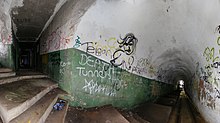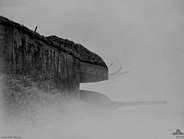Illowra Battery is a former Australian Army coastal-artillery battery located at Hill 60, Port Kembla, New South Wales in Australia, built and in service during World War II. It was also otherwise known as Hill 60 Battery.[1]
History[edit]
Two large naval-gun emplacements were constructed, both housing British BL 6-inch Mk. XI guns and complete with their protective gun-shields formerly held in storage from the decommissioned World War I-era Australian Navy cruisers HMAS Brisbane, Sydney and HMAS Melbourne. Two large tunnels were built to support the gun-battery and are steep in its descent underground and is fitted with a small-gauge tram/trolleyway used for hauling the guns' shells to their breeches located at the two coastal-gun emplacements above.

Aside from the two tunnels, a concrete bunker was also built and is connected to the tunnel system.
Illowra Battery was abandoned shortly after the end of World War II in 1945. A mushroom farm was established in its main bunker complex due to the cool temperature and adequate humidity within for the growing of such edible fungi. Today, the site remains popular with local visitors as well as urban explorers, who have added much colourful and diverse graffiti to the old battery's walls and remnants.




Well, that’s interesting to know that Psilotum nudum are known as whisk ferns. Psilotum nudum is the commoner species of the two. While the P. flaccidum is a rare species and is found in the tropical islands. Both the species are usually epiphytic in habit and grow upon tree ferns. These species may also be terrestrial and grow in humus or in the crevices of the rocks.
View the detailed Guide of Psilotum nudum: Detailed Study Of Psilotum Nudum (Whisk Fern), Classification, Anatomy, Reproduction